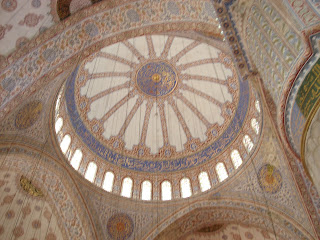 |
| courtesy of www.lonelyplanet.com |
The Blue Mosque
It was very appropriate, then, that our first visit was to the Blue Mosque. Built in the first half of the 16th century, the young Sultan Ahmet I was determined that his new mosque would be more glorious than the nearby AyaSofya (now a museum). That is why the Blue Mosque boasts six minarets instead of the usual four.
And the exterior appointments are merely the start. We made our way into its courtyard and up a flight of stairs. Along this outer corridor we were given a plastic bag in which to carry our shoes while inside. Once in the domed sanctuary, you notice long, low bench-like wooden pieces. These, I was informed, were for worshippers to place the bag of shoes during a service.
Well, Sultan Ahmet certainly succeeded here. The domes overhead are stunning, covered in gold filigree - verses from the Quran. And twinkling stained glass windows all around.
The carpet is a claret red dotted with the blue tulips. It's replaced often when it begins to look worn. The carpet was a gift to the Mosque from its faithful followers.
But the most phenomenal element is the collection of 20,000 hand-painted ceramic tiles, depicting 50 different tulip designs (seen around the domes above). This flower became known as the Flower of the Gods over time so it holds a reverent place here.
An interesting side note: the tulip did not originate in Holland. It is thought to have been cultivated by the Turks on 1000 AD. It wasn't until 500-600 years later that the Dutch became obsessed with the bloom and began their own industry in Northern Europe by bringing seeds from Turkey.
The Bosphorous Strait
The Bosphorous Strait runs alongside Istanbul - separating the continents of Europe and Asia. This body of water connects the Black Sea to the Aegean Sea (via the Dardanelles). Our boat ride took place on a perfectly beautiful day - nothing but a few white puffy clouds in a bright blue sky. It was rather a breezy journey so you literally had to hold on to your hat. The tour took us first toward the Black Sea along the European side, showing the beautiful homes and hotels along the way.
As we approached the entrance to the Black Sea, our vessel crossed over and proceeded back towards Istanbul along the Asian side. The lovely homes here had a different architecture but certainly not what westerners typically think of as Asian.
During our journey, we passed under the Bosphorous Bridge. Built in 1973, this suspension bridge connects the two continents. For many years, this was the longest suspension bridge outside of the United States.
The Spice Bazaar
This market is an amazing gathering place for many different cultures. Baseball caps shop right beside hijabs - in perfect peace. Just entering through its beautiful archway, the senses are immediately heightened. Numerous stalls present little hills of multicoloured spices - the scents of curry, cumin, saffron, pepper and coriander are all prominent here. I challenge you to name a spice that is not present.
Many owners highlight their perfume oils - the one I noticed most was rose petal. When it's a pure oil, it doesn't smell like your dear, old grandmother. I was tempted by our guide to try real, handmade Turkish Delight and I discovered that I loved it. So much so, in fact, that I purchased a box of pomegranate with pistachio. The flavours are many and the owners are happy to give you a taste (or 2 or 3).
There are other stalls along the walk that sell teas and coffees, belly dancing scarves and veils, and other trinkets and souvenirs. Almost anything you can dream up. While I shopped in one stall, I was treated to a little straw seat stool where I sat and enjoyed a cup of warm spiced apple tea. There were several older women doing the same (hmm...I wonder what that means for me!) - like queens in their black hijabs. It was a wonderful experience for all five of my senses.









No comments:
Post a Comment